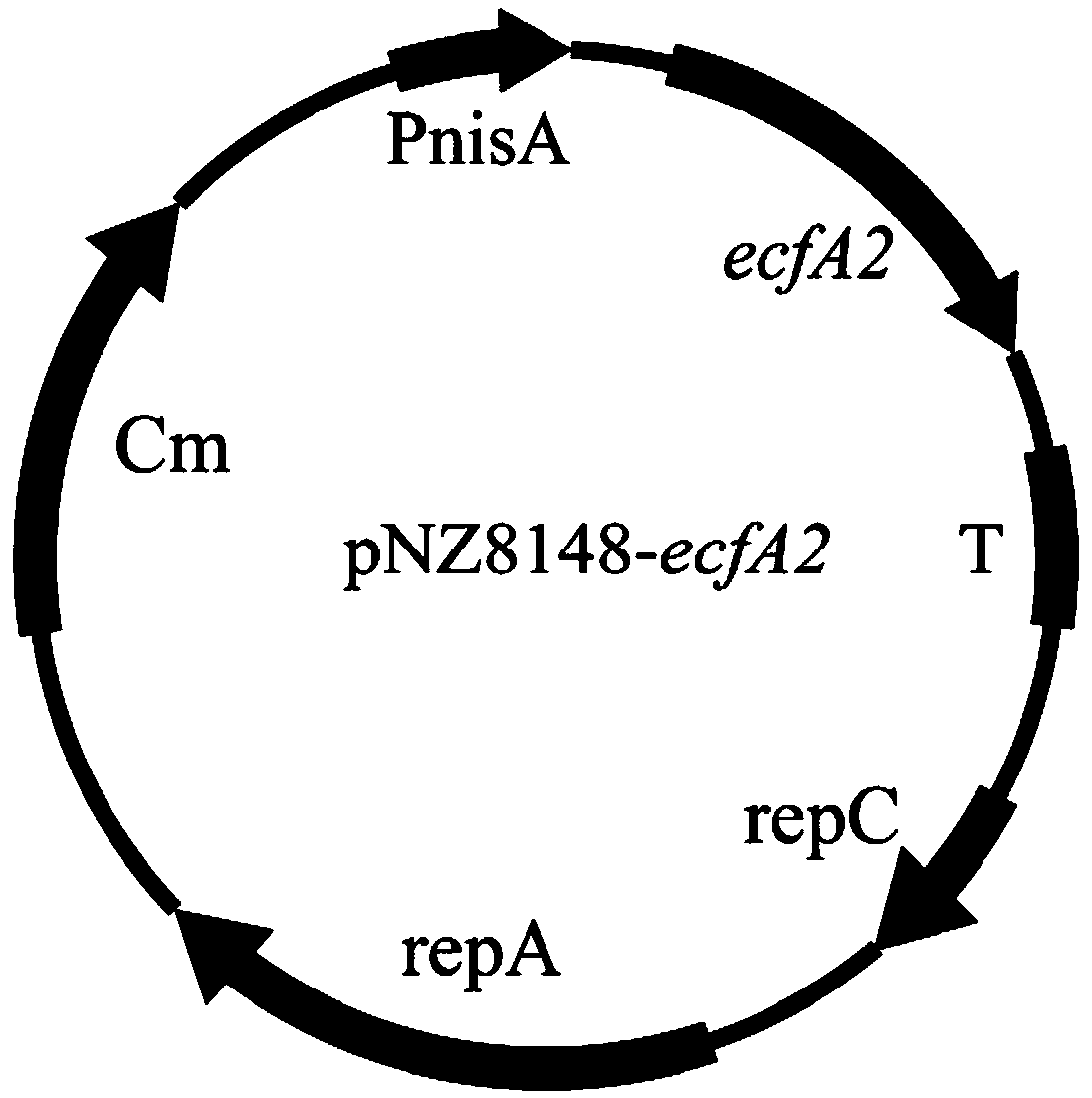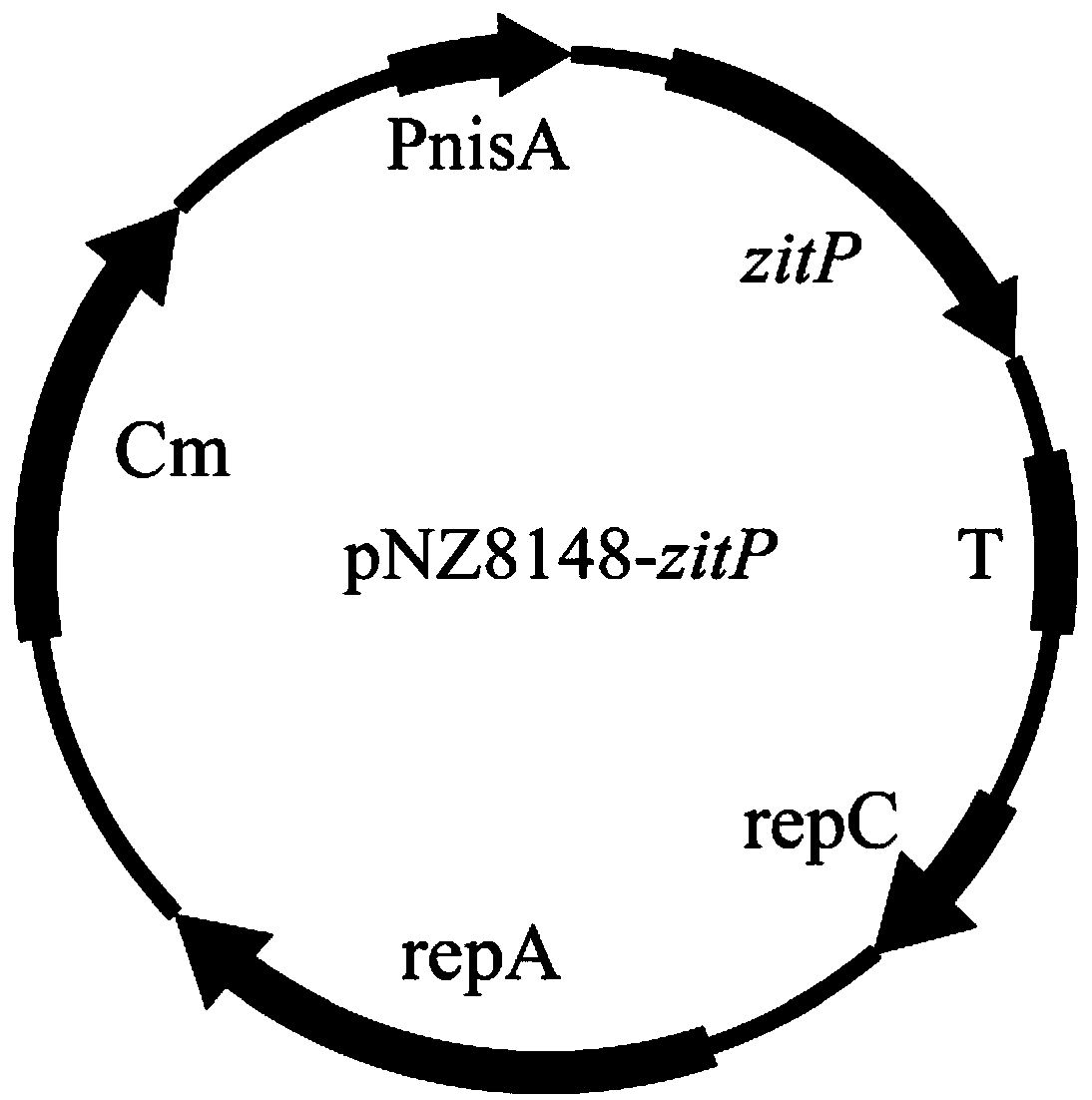Lactobacillus engineered bacterium with improved acid stress resistance and application thereof
A technology of lactic acid bacteria and engineering bacteria, which is applied in the field of genetic engineering and microbial engineering, can solve the problems of by-product accumulation, osmotic stress, and low success rate, and achieve the effect of improving acid stress resistance
- Summary
- Abstract
- Description
- Claims
- Application Information
AI Technical Summary
Problems solved by technology
Method used
Image
Examples
Embodiment 1
[0061] Embodiment 1: Construction of recombinant bacterial strain
[0062] Specific steps are as follows:
[0063] (1) Obtain the ecfA2 gene sequence shown in SEQ ID NO.1 from the NCBI database (the gene encoding the energy coupling factor transporter ATPase EcfA2, the protein used to transport ATP on the membrane), such as SEQ ID NO. The zitP gene sequence shown in 3 (the gene encoding the metal ion ABC transporter permease ZitP, the protein used to transport metal ions on the membrane), the zitQ gene sequence as shown in SEQ ID NO.4 (encoding the metal ion ABC transporter The gene of the ATP-binding protein ZitQ, the protein used to transport metal ions on the membrane), the bglF gene sequence shown in SEQ ID NO.5 (the gene encoding the IIABC component BglF of the β-glucoside specific PTS system, used The protein used to transport β-glucoside), the ganP gene sequence shown in SEQ ID NO.6 (the gene encoding maltose ABC transporter permease GanP, the protein used to transport...
Embodiment 2
[0071] Embodiment 2: the growth performance test of recombinant bacterial strain
[0072] Specific steps are as follows:
[0073] (1) The bacterial strain L lactis NZ9000 (pNZ8148) (control) and the bacterial strain L lactis NZ9000 (pNZ8148 / ecfA2), L lactis NZ9000 (pNZ8148 / zitP), L lactis NZ9000 (pNZ8148 / zitQ), Llactis NZ9000 ( pNZ8148 / bglF) and L lactis NZ9000 (pNZ8148 / ganP) were respectively inoculated in GM17 liquid medium supplemented with 10 μg / mL chloramphenicol for activation, and placed in a 30°C incubator for static culture overnight;
[0074] (2) Transfer the above-obtained seed solution to fresh chloramphenicol (10 μg / mL) GM17 liquid medium with an inoculum size of 2%, and culture it statically at 30° C.;
[0075] (3) During the culturing process, samples were taken at regular intervals to measure the OD value at a wavelength of 600nm;
[0076] (4) Cultivate to OD 600 Add 10ng / mL nisin at 0.4 to induce the expression of the transporter, take time as the abscissa...
Embodiment 3
[0080] Example 3: Tolerance test of recombinant strains under lactic acid stress conditions
[0081] Specific steps are as follows:
[0082] The bacterial strain L lactis NZ9000 (pNZ8148) (control) and the bacterial strains L lactis NZ9000 (pNZ8148 / ecfA2), L lactis NZ9000 (pNZ8148 / zitP) and lactis NZ9000 (pNZ8148 / zitQ) obtained in Example 1 were induced and cultured for 6 h, and the cells were collected by centrifugation , washed twice with 0.85% normal saline, resuspended in an equal volume of fresh GM17 (containing chloramphenicol 10 μg / mL) at pH 4.0 (adjusted by lactic acid), and stressed for different times; the bacterial suspension after stress was washed Resuspend in equal volume of normal saline after two times, take 10 μL of resuspension, dilute different gradients and plant on GM17 chloramphenicol plate to determine the number of viable bacteria and survival rate (the results are as follows: Figure 9-11 shown);
[0083] Survival rate = (N / N 0 )×100%;
[0084] Amo...
PUM
 Login to View More
Login to View More Abstract
Description
Claims
Application Information
 Login to View More
Login to View More - R&D
- Intellectual Property
- Life Sciences
- Materials
- Tech Scout
- Unparalleled Data Quality
- Higher Quality Content
- 60% Fewer Hallucinations
Browse by: Latest US Patents, China's latest patents, Technical Efficacy Thesaurus, Application Domain, Technology Topic, Popular Technical Reports.
© 2025 PatSnap. All rights reserved.Legal|Privacy policy|Modern Slavery Act Transparency Statement|Sitemap|About US| Contact US: help@patsnap.com



